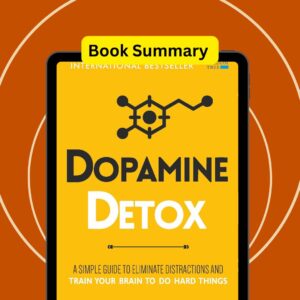Understanding Dopamine Detox: A Comprehensive Summary and Guide
In today’s fast-paced world, the constant barrage of stimuli can lead to overstimulation, making it challenging to focus and achieve our goals. “Dopamine Detox,” a concept popularized by Thibaut Meurisse, offers a practical approach to reclaiming our attention and enhancing productivity. This blog will delve into the key principles of dopamine detox, its benefits, methods for implementation, and how it can transform your life by reducing distractions and fostering deeper engagement with meaningful tasks.

Table of Contents
What is Dopamine?
Dopamine is a neurotransmitter that plays a crucial role in the brain’s reward system. It is often referred to as the “feel-good” chemical because it is released during pleasurable activities, such as eating, socializing, or engaging in hobbies. However, dopamine is not merely a pleasure chemical; it also drives motivation and goal-directed behavior.
The Role of Dopamine in Modern Life
In our modern environment, we are constantly exposed to stimuli that trigger dopamine release—social media notifications, binge-watching shows, and instant gratification from various sources. While these activities can provide temporary pleasure, they often lead to a cycle of dependency where individuals require increasingly stimulating experiences to achieve the same level of satisfaction. This overstimulation can impair our ability to concentrate on long-term goals and engage in more meaningful activities.
What is a Dopamine Detox?
A dopamine detox involves intentionally reducing or eliminating activities that trigger excessive dopamine release to recalibrate your brain’s response to stimulation. The goal is not to eliminate dopamine entirely but rather to create a healthier balance that allows you to regain focus and motivation for tasks that matter.
Why Do a Dopamine Detox?
- Reduce Sensory Overload: By cutting back on high-stimulation activities, you can decrease sensory overload and improve your ability to concentrate.
- Enhance Productivity: A detox helps you focus on long-term goals by minimizing distractions and fostering deeper engagement with your work.
- Improve Mental Well-being: Reclaiming control over your attention can lead to increased satisfaction and fulfillment in daily life.
Types of Dopamine Detox
1. Total (Complete) Detox
The total detox requires eliminating all dopamine-inducing behaviors for an extended period—typically 24 to 48 hours. During this time, you should refrain from engaging in activities such as:
- Browsing the internet
- Watching television or movies
- Using social media
- Consuming processed foods or sugar
- Engaging in substance use (alcohol or drugs)
Instead, focus on low-stimulation activities like journaling, meditation, walking in nature, or gentle stretching.
2. Limited (Partial) Detox
The limited detox involves identifying your most significant source of dopamine stimulation—such as social media or junk food—and eliminating it for an extended period (e.g., 30 days). This approach allows for a gradual reduction in stimulation while still enabling you to engage in other enjoyable activities.
3. Customized Detox
For those who may find total or limited detoxes too challenging, a customized approach can be developed based on individual needs and triggers. This could involve setting specific boundaries around certain activities rather than eliminating them entirely.
Implementing a Successful Dopamine Detox
Step 1: Identify Your Addictive Behaviors
Begin by reflecting on which activities you find most addictive or distracting. Consider behaviors that you feel compelled to engage in despite their negative impact on your productivity or well-being.
Step 2: Add Friction to Distractions
Once you’ve identified your triggers, create barriers that make these distractions less accessible. For example:
- Disable notifications on your phone.
- Uninstall distracting apps from your devices.
- Store devices out of reach while working.
Adding friction helps reduce impulsive engagement with high-dopamine activities.
Step 3: Establish a Morning Routine
Your morning routine sets the tone for the day ahead. Start each day with low-stimulation practices such as meditation, exercise, or reading non-stimulating material. This routine helps maintain low levels of stimulation throughout the day and enhances focus.
Strategies for Success
- Practice Self-Awareness: Be mindful of when you start reverting to old habits during your detox journey. Recognizing these patterns is crucial for maintaining progress.
- Cultivate Present-Mindedness: Engage in mindfulness practices that encourage you to focus on the present moment rather than seeking external validation or stimulation.
- Be Kind to Yourself: Understand that the world is designed for sensory overload; it’s normal to struggle during this process. Approach your detox with compassion and patience.
Benefits of Dopamine Detox
- Increased Focus: By reducing distractions and recalibrating your brain’s response to stimulation, you’ll find it easier to concentrate on important tasks.
- Improved Mental Clarity: A detox can lead to clearer thinking and better decision-making as you become less reliant on instant gratification.
- Enhanced Creativity: With fewer distractions vying for your attention, you’ll have more mental space for creative thinking and problem-solving.
- Greater Satisfaction: As you engage more deeply with meaningful tasks, you’ll experience a sense of fulfillment that comes from achieving long-term goals.
Overcoming Challenges During Detox
Embarking on a dopamine detox can be challenging, especially when faced with withdrawal symptoms from reduced stimulation. Here are some tips for overcoming these challenges:
- Stay Committed: Remind yourself of the reasons behind your detox and the benefits you’re aiming for.
- Document Your Journey: Keep a journal during your detox process to track your feelings, challenges faced, and moments of clarity or success.
- Seek Support: Share your goals with friends or family members who can provide encouragement and accountability throughout your journey.
FAQs for Dopamine Detox Summary
What is dopamine detox?
Dopamine detox is a strategy aimed at reducing the overstimulation of the brain’s reward system by temporarily abstaining from activities that trigger dopamine release, such as social media, video games, and junk food. The goal is to reset the brain’s reward pathways and improve focus and motivation.
How does dopamine detox work?
The process involves taking a break from high-dopamine activities for a set period, allowing the brain to recalibrate. By minimizing distractions, individuals can experience increased clarity, improved self-control, and a greater appreciation for simpler pleasures.
What are the benefits of a dopamine detox?
Benefits of dopamine detox may include:
- Enhanced Focus: Reduced distractions can lead to improved concentration on tasks.
- Increased Productivity: By eliminating time-wasting activities, individuals can allocate more time to meaningful pursuits.
- Improved Mood: A break from overstimulation can lead to a more balanced emotional state.
- Greater Self-Control: Learning to resist immediate gratification can strengthen willpower.
How long should a dopamine detox last?
The duration of a dopamine detox can vary based on individual preferences and goals. Some people opt for a single day, while others may choose to extend it for a week or longer. The key is to find a timeframe that feels manageable and effective.
What activities should be avoided during a dopamine detox?
During a dopamine detox, it’s advisable to avoid:
- Social media and digital devices
- Video games
- Junk food and sugary snacks
- Television and streaming services
- Any other activities that provide instant gratification
Can I still engage in productive activities during a dopamine detox?
Yes, you can engage in low dopamine activities that promote mindfulness and self-reflection. Examples include reading, journaling, meditating, exercising, or spending time in nature.
Is dopamine detox suitable for everyone?
While many people can benefit from a dopamine detox, it may not be suitable for everyone. Individuals with certain mental health conditions should consult with a healthcare professional before attempting this practice.
How often should I do a dopamine detox?
The frequency of dopamine detoxes depends on personal needs and lifestyle. Some individuals may find value in doing it weekly or monthly, while others might prefer occasional resets when feeling overwhelmed by distractions.
What should I expect after completing a dopamine detox?
After completing a dopamine detox, many individuals report feeling more focused, motivated, and appreciative of simple pleasures. It may take time to fully adjust back to regular activities without falling into old habits.
Conclusion
Dopamine detox offers a powerful framework for reclaiming control over our attention and enhancing productivity in an increasingly distracting world. By intentionally reducing overstimulation through various detox methods, individuals can cultivate deeper focus, improve mental well-being, and foster genuine engagement with their goals. As we navigate our daily lives filled with digital distractions and instant gratification opportunities, embracing the principles of dopamine detox can lead us toward more fulfilling experiences and help us achieve our long-term aspirations. By understanding how dopamine influences our behaviors and taking proactive steps toward managing our stimulation levels, we can embark on a transformative journey toward greater productivity and satisfaction in both personal and professional realms. This comprehensive overview provides an SEO-optimized summary of “Dopamine Detox,” capturing its core concepts while ensuring readability and engagement for readers interested in personal development strategies focused on enhancing focus and productivity.




